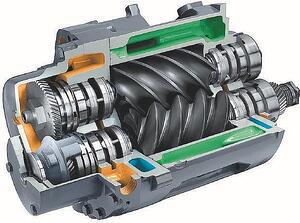Do compressor oil manufacturers know the service life of the mineral or synthetic oils they offer, at least theoretically? Do they know that rotary compressors, even of the same make, model and power rating, have their own history and specific operation?
Do they know that operating conditions can heavily affect both compressor performance and the service life of the lubricating oil?
In this article, we will try to clarify these factors by analysing some of the most important checks that must be carried out if you want to monitor the residual useful life of compressor oils in operation in order to safeguard the functionality of the machines.
Rotary compressor lubrication
Analysis of the 5 properties of an excellent lubricating oil for rotary compressors
DOWNLOAD NOW
(1) External appearance of the oil: colour index
The colouring of lubricating oils can be linked to various factors, often from external components such as contaminants, additives, water or purely commercial aspects. The particularly "lively" colour (such as blue or red) is added to facilitate recognition and/or to distinguish one product from another. In other cases, the colouring indicates a special degree of refinement. However, in all cases, the ASTM D 1500 method (and for some special oils, the Saybolt method) is used for the determination of colour, by comparing the sample with a graduated scale with values ranging from 0 (practically colourless) to 8 (dark brown).
Note that spent or already-stressed oils have a darker colour.
(2) Change in viscosity
This is the tendency of a fluid to oppose motion, being the internal friction of the fluid itself. It is precisely for this reason that the viscosity used for classifying lubricants is called kinematics and is measured in cSt (centiStokes) through the use of special glass capillaries, the most famous of which are the Ubbelohde. The time required for a specific volume of fluid under certain temperature conditions to cross a path identified within the aforementioned calibrated capillary is measured with a stopwatch, on the basis of gravity alone.
Note that the variation and, in particular, the increase in viscosity during the life of the compressor can be linked to evaporation phenomena of the lighter fractions of the oil due to the high operating temperatures. Viscosity is an important parameter since an excessive increase can cause a rise in absorption and mechanical wear.
(3) Determination of carbon residue
This is used to measure the residue amount following evaporation of the oil under established and controlled conditions. The Conradson method used in many European countries and standardised by ASTM D 189, involves using 10 grams of oil in a porcelain crucible of known weight. The crucible is then heated with a flame, continuing the heating operation until the vapours developed by the oil stop burning, at which point heating is suspended. Through simple mathematical calculations, the residual weight and the percentage of the original sample are measured. With this test, not only the amount of carbon present is measured but also, in the case of used oils, all the ashes that may derive from the presence of any metal additives, powders and other metal particles derived from the wear of the mechanical part.
Note that the presence of solid residues can cause premature wear and even seizure.
(4) Acidity: Total Acid Number (TAN) test
In this case, a normal titration is performed in the laboratory and measures the milligrams of potassium hydroxide necessary to neutralise all acid components present in the oil generated as a result of the degradation of the lubricating oil itself.
Note that too-high acidity values indicate wear of the oil and represent a potential attack on metal surfaces.
(5) Ash content
We have just seen that through the determination of the carbon residue, all the metal components are also measured that in some way contribute to characterising a lubricating oil making it suitable for the specific application. Furthermore, if we consider an oil in operation, even all the substances such as dust or wear particles that are not burned will contribute to giving weight to the measured value.
To determine the ash present according to the ASTM D 874 standard, a 10-gram sample of oil must be filtered with a 0.149-mm mesh filter. Heating operations are then repeatedly carried out, with the addition of small quantities of sulfuric acid, treated in a muffle up to 550° C then subsequently cooled until two consecutive weighings of the crucible total less than 1 mg. The percentage of the ashes is then obtained by dividing the final weight of the sulphated ashes by that of the original sample, making the whole ratio 100.
(6) Demulsivity
This is the intrinsic ability of an oil to separate from water in static conditions. By vigorously mixing two equal quantities of water and lubricating oil (40 ml at 54° C), the time required for the level of the emulsified part to be reduced to 3 ml is measured.
Note that this property is essential especially for compressor lubricants, as any excessive presence of water would generate the formation of foam with consequent corrosion phenomena, with a decrease in viscosity and thus in the lubricating power.
(7) Wear metals
Also in this case, the analysis is fundamental for this type of lubricants. Through a special instrument (ICP Plasma), any metal (copper, tin, aluminium, iron and so on) is detected inside the lubricant which, often beingexternal to both the formulation and the additive of the lubricant itself, signals in advance phenomena of localised wear and/or corrosion that are happening inside the circuit or in some part of the compressor (such as in the valves, motor, gears, bearings, etcetera).
(8) Foaming
For this measurement, pressurised air is blown into a graduated cylinder containing oil at a given temperature (24° C). After a rest period of about 10 minutes, the height of the remaining foam is measured in centimetres. This operation can also be carried out manually, at room temperature, by vigorously shaking the aforementioned cylinder and checking the height of the remaining foam and in many cases, also how long it takes to disappear completely from the cylinder.
Note that the foam has no lubricating power, thus its excessive formation during operation due to the "flapping" of the moving parts, can be negative for the protection of the friction surfaces under the wear aspect.
(9) Compatibility oil-gaskets
Last but not least, the gaskets and sealing rings incorporated in the machines must necessarily maintain a neutral behaviour towards the lubrication oils, in order to avoid dangerous dimensional and structural variations.
In this article, we have seen which parameters can be monitored to establish the residual health of the lubricant oil operating inside a compressor and therefore indirectly establish the replacement and/or top-up operations. Some methods are quite simple and straightforward, whereas others require more complex equipment and longer response times.
The guide below analyses some of the most important characteristics that a compressor oil must have to ensure optimal performance and prolonged replacement cycles.





